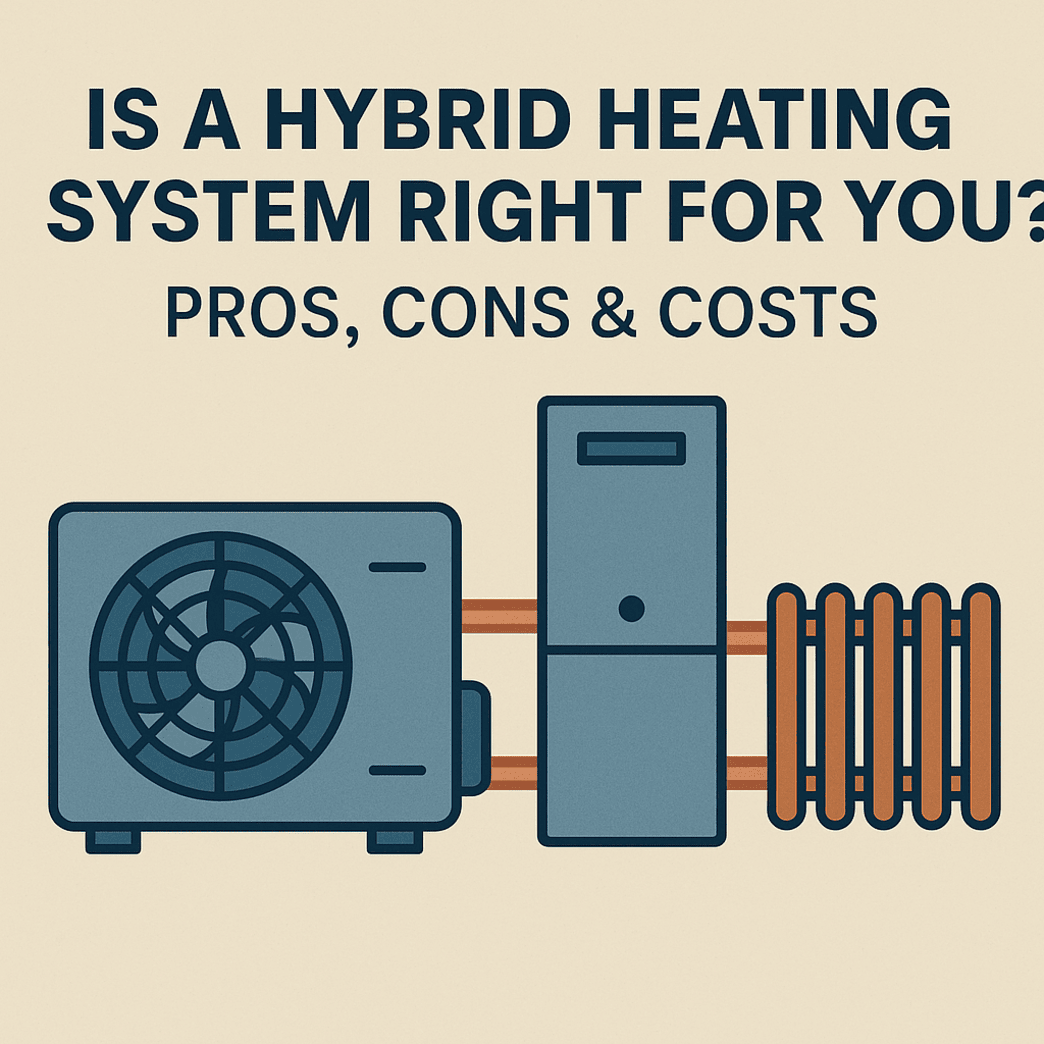As homeowners seek smarter, greener, and more cost-effective solutions for comfort, hybrid heating systems—which combine the reliability of a gas furnace with the efficiency of an electric heat pump—have emerged as a trending choice. But is this dual-source heating solution the right fit for your home? Let’s dive deep into the pros, cons, and costs of hybrid heating systems so you can make an informed decision.
What Is a Hybrid Heating System?
A hybrid heating system—sometimes called a dual-fuel system—integrates two different heat sources:
- Electric heat pump: Works efficiently in moderate weather, drawing heat from the air outside to warm your home.
- Gas furnace: Activates when temperatures drop significantly and the heat pump loses efficiency, ensuring reliable warmth during harsh winters.
The system automatically switches between these energy sources to maximize efficiency while keeping your home comfortable. This intelligent combination is designed to reduce utility costs while maintaining comfort year-round.
How Does a Hybrid Heating System Work?
- Mild Weather: The heat pump handles most of the heating needs since it operates efficiently down to about 35–40°F.
- Colder Temperatures: When outdoor temperatures dip below the efficient range for heat pumps, the gas furnace takes over.
- Smart Thermostat Control: Many hybrid systems are paired with programmable or smart thermostats that automatically decide when to switch from electricity to gas for maximum savings and comfort.
Pros of Hybrid Heating Systems
1. Energy Efficiency
Hybrid systems use the electric heat pump as the primary heating source in mild weather, significantly reducing energy consumption compared to running a furnace alone.
2. Lower Utility Bills
By alternating between electricity and natural gas, you can take advantage of cheaper energy rates depending on the season, leading to noticeable savings.
3. Eco-Friendly Operation
Heat pumps are cleaner than fossil fuels, reducing your home’s carbon footprint during much of the heating season.
4. Year-Round Comfort
Because heat pumps also provide air conditioning, a hybrid system offers both heating and cooling in one unit, eliminating the need for separate systems.
5. Reliability in Cold Climates
Unlike traditional heat pumps that struggle in extreme cold, the gas furnace backup ensures your home stays warm even during severe winters.
Cons of Hybrid Heating Systems
1. Higher Upfront Costs
A hybrid system typically costs more to install than a single furnace or heat pump, which can deter some homeowners.
2. Complex Installation
Since the system integrates two heating technologies, installation requires skilled technicians and can be more time-consuming.
3. Maintenance Requirements
Both the furnace and heat pump need regular servicing, which can mean higher ongoing maintenance expenses compared to a single-unit system.
4. Not Ideal in Mild Climates
In regions with consistently mild winters, a hybrid system may not deliver enough benefits to justify the higher investment.
Cost of a Hybrid Heating System
The price range for installing a hybrid heating system depends on the size of your home, the equipment brand, and local labor rates:
- Heat pump unit: $4,000 – $7,500
- Gas furnace unit: $3,000 – $5,500
- Full installation cost (combined): $7,000 – $15,000
Additional costs may include ductwork modifications, smart thermostat installation, or energy efficiency upgrades. While the upfront investment is higher, many homeowners recover the difference within 5–8 years through reduced energy bills.
Savings Potential
A well-designed hybrid system can cut your annual heating bills by 20%–50%, depending on:
- Climate and average winter temperatures
- Current heating fuel prices (electricity vs. gas)
- Energy efficiency of your home (insulation, windows, etc.)
In states with fluctuating gas and electric prices, hybrid systems allow you to choose the cheaper energy source, maximizing savings.
Is a Hybrid Heating System Right for You?
A hybrid heating system is an excellent choice if you:
- Live in an area with cold winters but mild fall and spring seasons
- Want to reduce your carbon footprint while saving on energy bills
- Need both heating and cooling in one system
- Are willing to make a higher upfront investment for long-term benefits
On the other hand, if you live in a region with mild winters, or if you plan to sell your home soon, a hybrid system may not deliver the same return on investment.
Hybrid Heating vs. Traditional Systems
| Feature | Hybrid System | Gas Furnace Only | Electric Heat Pump Only |
| Efficiency | High (switches energy sources) | Medium | High (mild weather only) |
| Upfront Cost | High | Medium | Medium |
| Cold Weather Reliability | Excellent (furnace backup) | Excellent | Low (inefficient in cold) |
| Eco-Friendly | Yes (heat pump use) | No (fossil fuels) | Yes |
| Year-Round Comfort | Yes (heating + cooling) | Heating only | Yes (heating + cooling) |
Final Thoughts
A hybrid heating system is not just a trend—it’s a forward-thinking solution that blends comfort, savings, and sustainability. While the upfront costs can be higher, the long-term energy savings, reliability in cold weather, and eco-friendly benefits make it an investment worth considering for many homeowners.


